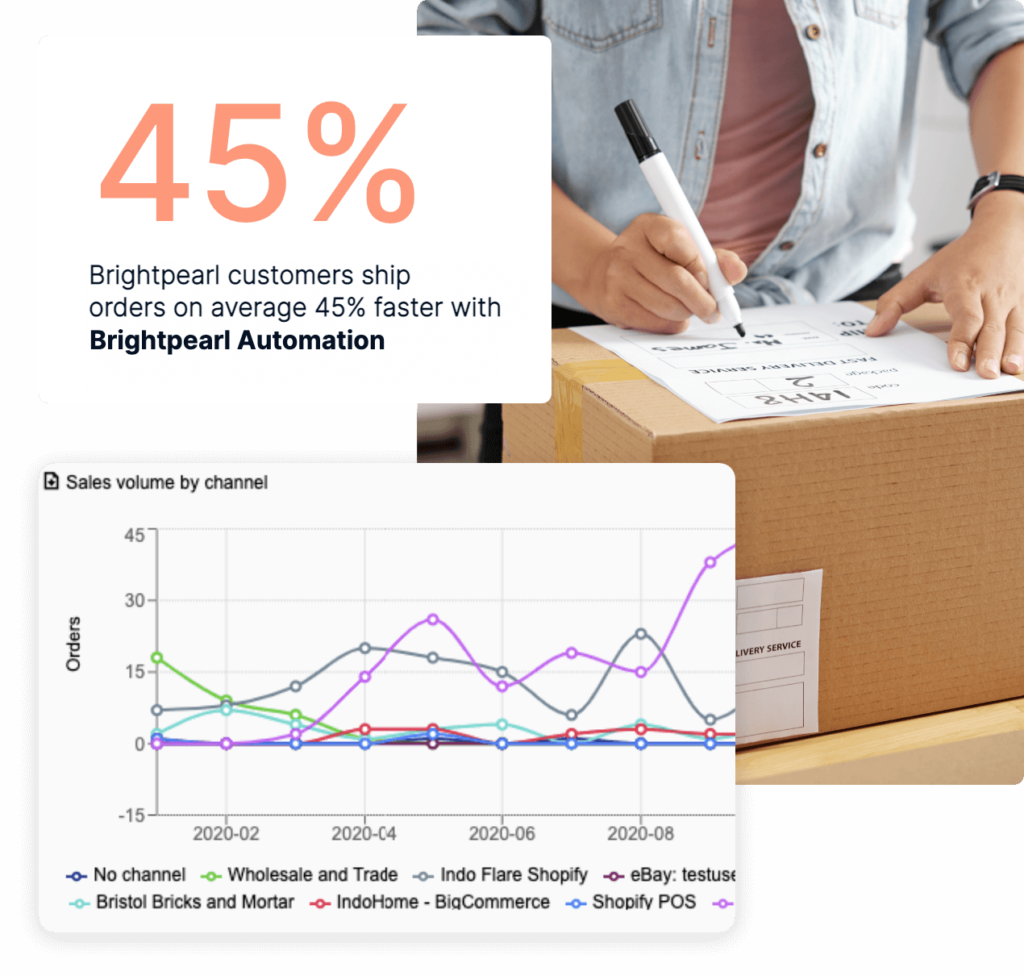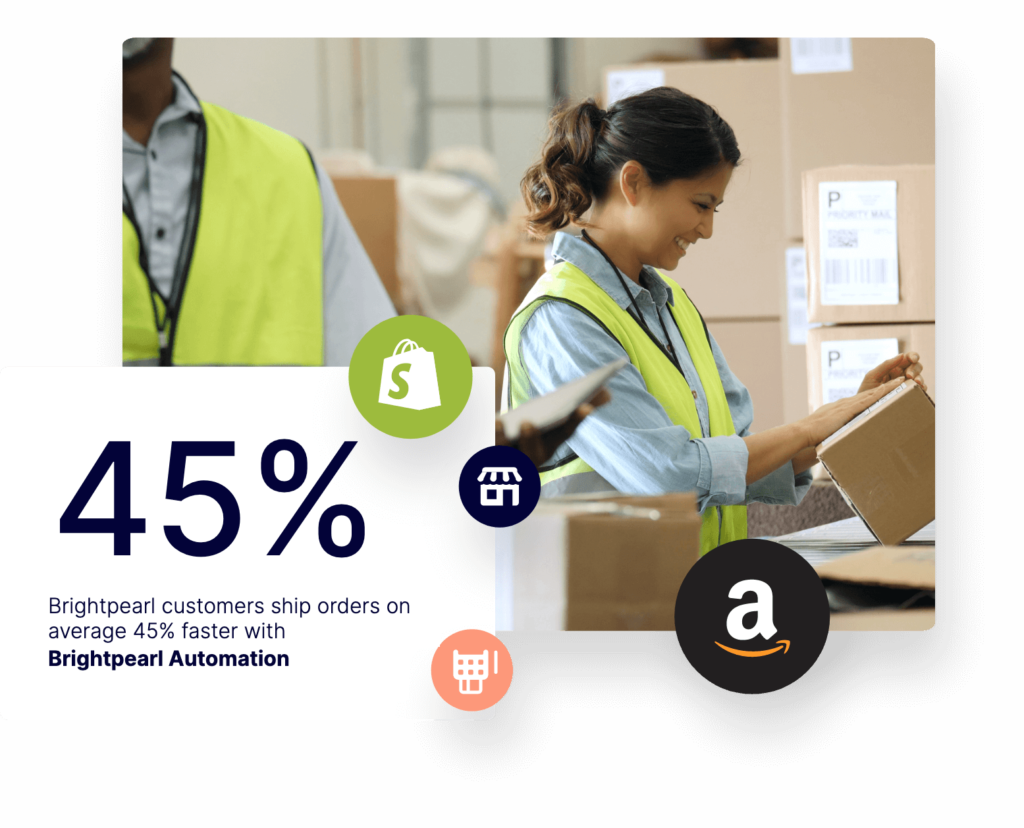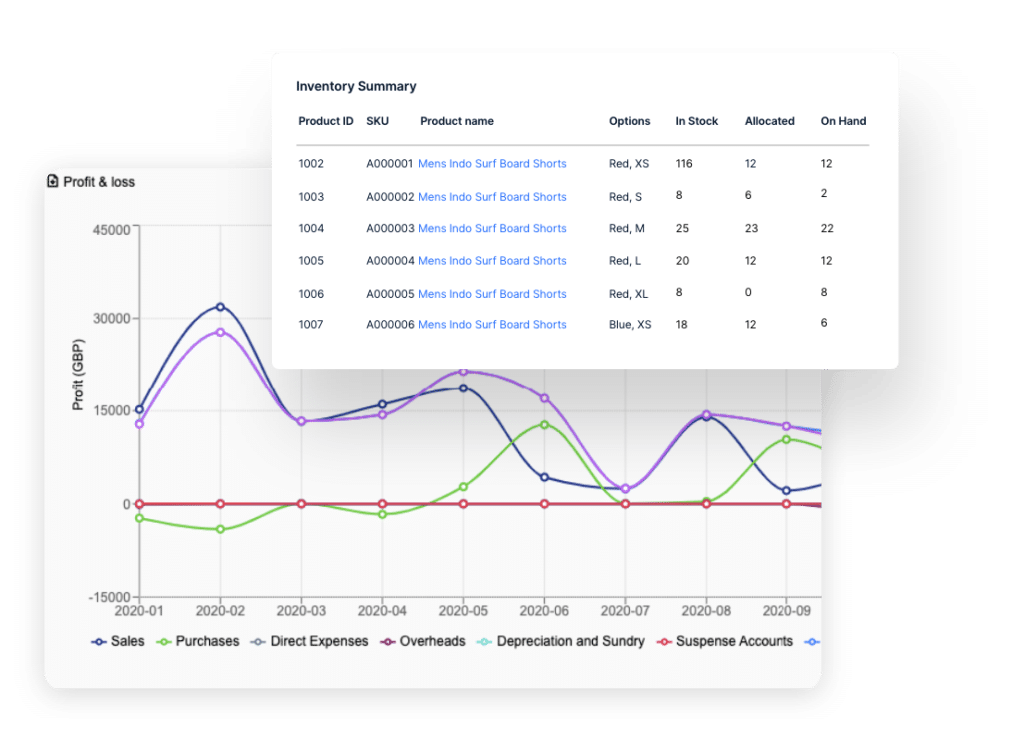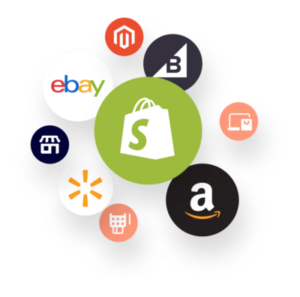E-Commerce is in the midst of a global growth trend that is transforming the online retail landscape. This shift has only accelerated since the beginning of the Covid-19 pandemic, as more consumers have been driven online.
With e-commerce sales soaring, the order management process, warehouse management, and order fulfillment process have been under increased pressure.
2022 is set to be the first trillion-dollar year for e-commerce. Retailers must be ready to meet the increasing demand for products/services with efficient and expedited order processing.
What is e-commerce order management?
In a nutshell, e-commerce order management is the process of tracking an order from the initial purchase transaction, through the entire fulfillment process, to the point a customer receives their goods. At each stage, data is collected, so the customer order can be tracked through its lifecycle.
Order management is a critical component of an online store’s order filling system. It contributes significantly to the customer experience, dictating the speed and ease with which a customer receives their purchased goods.
A productive order management system should encompass all the features required to monitor, trace, and control the process. At the very least, it should consist of the following:
- Customer communication
- Sales via multiple channels
- Tracking inventory and supply chains
- Logistics and third-party logistics (3PL)
- Customer service
Without efficient order management, the process can quickly become complex and overwhelming, especially when managing orders across multiple channels and distribution centers. Consider an order management solution (OMS) to handle your orders more productively and generate higher profits.

How do you manage e-commerce orders?
Managing e-commerce orders is all about optimizing the order routing and fulfillment process, while reducing the number of errors that occur along the way.
Although the workflow can vary per purchase, the steps of a typical order process include:
- A customer places their order online, through the company website or a third-party e-commerce platform.
- The business logs and accepts the purchase order. They do this either manually or through order management software.
- The customer receives an email confirmation that their order has been received and payment has been taken. A delivery estimate may also be provided, or a link to follow the order status.
- A sales order is generated, and items from the order are allocated to it from a company’s inventory. Again, this process can be manual or function through OMS automation.
- The order details are sent to the company’s warehouse. Stock levels are checked, and product availability is confirmed. Then, goods are picked, packaged, and shipped by the warehouse team.
- Customers receive confirmation that their order has been dispatched. A company may also supply information to track orders through the delivery process. At this stage, after checking inventory levels, a firm can contact its suppliers to restock.
- The customer receives their purchase, and checks are made to assure customer satisfaction.
- (Possible) The customer raises an issue by contacting the business, by email, through social media, etc.
- (Possible) Any issues that have been raised are resolved. This could be by providing a replacement product, issuing a refund, or offering other solutions. Here, a company must account for the inventory or financial implications of resolving the issue.
- The company can now reach out for a customer review.

Image Source
E-Commerce order management challenges
Order management affects every stage of the supply chain. It has a direct impact on the way consumers regard your brand and is a central agent in providing a seamless multichannel customer experience.
Where companies are concerned, it provides for integrated business planning. Good order management allows supply and demand decisions to be based on real-time, consistent data and accurate forecasting.
For both larger enterprises and small businesses, there can be considerable challenges in customer order management. Wholesalers, manufacturers, and distributors are expected to respond to evolving customer expectations but often lack the tools required to keep up with consumer demand.
Difficulties in order monitoring, forecasting accuracy, and order promising are challenges that e-commerce businesses face at every level of the order management process. To ensure customer satisfaction, an OMS can assist in instituting best practice procedures through every stage of a company’s supply chain, from e-commerce order management to inventory control, and shipping/fulfillment procedures.
Why e-commerce order management systems are important
An OMS streamlines the entire virtual business process. It can provide automation and integration at every stage of the e-commerce lifecycle and offers scalability across various online stores and shopping channels.
Within a single interface and integrated APIs, an OMS can help your business manage orders made from various sales points and ship them from multiple fulfillment centers. If your company embraces the omnichannel user experience, an OMS is an essential all-in-one solution for optimizing your cross-platform e-commerce operations.
Order management systems provide SMEs with a plethora of growth opportunities. Here are just a few ways they can improve your business functionalities and ensure customer satisfaction:
Improve inventory accuracy
An OMS that includes inventory management software offers dramatic improvements for your warehouse performance. Such a system can monitor inventory levels with precision, as they fluctuate with business demands. It will also anticipate stock levels based on critical key performance indicators.
The best systems—those tailored to retail—will provide greater inventory visibility, and eliminate the common challenges of inventory management. Ultimately, implementing inventory management software means fewer missed sales through issues such as overselling and inaccurate forecasting.
Centralizing your view of operations across sales channels will mean avoiding errors from manual processes or syncing complications from disjointed systems. It allows users to manage their inventories in multiple locations from just one source. With automatic updates, businesses can adjust their stock according to precise order quantities and thus account for insufficiencies in supply hindering sales or excess stock reducing revenue.
Whether a business relies on traditional inventory or dropshipping, an inventory management system can automate the supply chain in various ways to maximize productivity. For example, allocating and reallocating stock, adding a free SKU, updating customer fields, invoicing orders, updating shipping methods, and generating shipping labels are among numerous actions compatible with automation.
Mismanaging inventory can substantially affect a business’s bottom line. To avoid this, accurate inventory control is crucial. Investing in smart software like Brightpearl will make the entire order management process smoother, easier, and more profitable. Unlike traditional enterprise resource planning (ERP) systems, Brightpearl provides a digital operations platform (DOP) that is flexible and scalable as your business grows.

Enable omnichannel selling
An OMS’s robust reporting and e-commerce analytics allow for faster and better-informed decision making. This is essential for omnichannel merchants insofar as it makes managing multi-channel orders a much simpler process. With a consolidated view of customer orders and relevant data, firms can spot issues more quickly and can be more agile in responding to market shifts.
Managing multiple platforms can be complex and labor-intensive. Unifying customers, suppliers, inventories, and sales channels in one system reduces operational costs and saves time. This means you can reallocate workers to more critical tasks.
In the modern day, consumers have come to expect an integrated and cohesive omnichannel retail experience. Automated order entry, processing, and shipping software ensures that the customer order experience is consistent, no matter where they purchase.
Faster Delivery and Fulfillment
Once payment has been made, the next most important part of the e-commerce order management process is the speed and accuracy of order fulfillment. The sooner a customer receives their correct order, the more satisfied they will be with your service. Indeed, 57% of consumers are reluctant to re-purchase from the same retailer, once a delivery is late.
An order management system is a simple way of avoiding processing delays and ensuring a good customer experience. Integrating shipping services facilitates more prompt delivery times, especially for bulk orders. They do this by reducing the quantity of manual work necessary, automating time-consuming tasks, and cutting down on human error.
Indeed, when a customer places their online order, an OMS can choose their closest warehouse or fulfillment center to expedite shipping times. From here, it will send an automated fulfillment request to the chosen warehouse so that staff can begin preparing an order for delivery as soon as possible.
Top OMS providers offer integrations with leading shipping partners, like FedEx and USPS, allowing users to manage their shipping carriers in one place and ensure the highest quality of service for customers.

Scalability
Order management systems promote long-term scalability by creating more integrated supply chains. The most advanced systems will offer expansions in functionality as your business grows. While legacy systems can be overwhelmed by sudden changes in omnichannel fulfillment needs, an OMS can easily scale its operations to keep pace with company growth.
To stay competitive, companies need scalable solutions that can adapt in response to shifting industry trends. An OMS built on an SaaS infrastructure and with cloud-based operations provides enhanced flexibility. All internet-enabled devices can access the system, whatever their location. This means remote teams can contribute to order management as efficiently as domestic users.
Ideally, an order management solution should allow businesses to customize their services based on their changing needs. Brightpearl offers agility at scale with customizable order management workflows, the ability to allocate back orders, integrated POS, and more.
Key features of an effective e-commerce order management system
An effective e-commerce order management system organizes various services to remove the complexity of manual processes.
Here are a few of the key features it supplies to retailers:
Eliminate manual processes with automation
The most advanced OMS will automate actions in both fulfillment and warehouse management processes, providing a one-stop solution. Automation rules will adapt to the unique needs of your business by analyzing your processes.
Eliminating the need to handle order changes manually, automation speeds up the productivity of your company by providing real-time financial reporting and auto-invoicing, instantly hitting dispatch targets with the auto-filling of new orders, and using auto-tagging to group customers for marketing.
The best order management software will allow you to create multiple automated fulfillment rules to cater to different scenarios. It will check for new orders constantly and apply those rules to eligible orders immediately. Where a manual process may have taken hours, the logistics of shipping a product to a customer can be handled by a competent OMS in seconds.

Work on every sales channel
One of the most essential features an OMS provides is the ability for multi-channel sales order management. Centralizing orders from all channels in one system, an OMS allows businesses better visibility of their entire order processing operation.
There is also a seamless data flow across e-commerce channels so that your company can deliver a more personalized service. Providers that offer integrations with companies like Amazon and eBay allow for customer account information, stock levels, product details, and pricing to be shared across platforms so that users can avoid the pitfalls of badly synchronized order integration.
Regardless of where your customers’ point of purchase is, data is shared across sales channels so that decisions can be made with the most up-to-date customer statistics, and without the need for manual admin.
No limits on order volumes
As a small or medium-sized business relying on small teams to fulfill orders, it can be impossible to scale the volume of accepted purchases. An OMS reduces the need for manual work and thus dramatically expands the number of orders a company can process, whatever its size.
With the best order management technology, a business can manage order volume growth without employing more staff. Indeed, an automated system avoids the costly human errors that can arise in high-volume order processing. Through configured bulk actions and repeat tasks, each order becomes as easy as the next, no matter its volume.
Provide real-time view on inventory
An order management system is purpose-built to receive real-time views of inventories from multiple sources. This means that businesses can calculate their Available to Sell (ATS) inventories with accuracy. Retailers that rely on ERP systems receive a general estimate of stock availability, with little communication between the point-of-sale system (POS) and the rest of the fulfillment ecosystem.
Conversely, an OMS offers a unified view of inventory feeds across multiple systems and can also incorporate a real-time view of third-party inventories. With this system in place, vendors can see precisely how much stock they have available to sell.

Forecast replenishment
Effective order management solutions will predict exactly how much safety stock you require to avoid over-ordering and overselling. Working with up-to-date analytics and sales projections, an OMS can plan your supply needs to ensure demand is satisfied without producing deadstock.
Manual forecasting can be a difficult task, dependent on several variables where errors can significantly reduce the accuracy of predictions. Automated forecasting avoids these problems. It can anticipate future up- and down-turns based on past data and order replenishments in response to immediate changes in inventory.
Provide insights by sales channel, product, and customer
An OMS can help you reach your performance goals by providing insights specific to the products you offer and the customers that purchase them. Depending on the software you choose, a system can offer insights through methods like retail reporting analytics and business intelligence.
Combining real-time sales and performance data, a good quality OMS can supply your team with the relevant insights to streamline their processes. With the metrics most relevant to their roles, better decision-making is ensured across your company.
With Brightpearl, merchants obtain a set of dashboards and KPIs based on data held within the operations platform. This ensures end-to-end performance visibility and means that business decisions are made based on wide-ranging analytics. This means that businesses receive a more complete picture of operations and can thus focus on the necessary products, channels, regions, and customers that will drive growth.
Extensible integration capability
The most optimal OMS will integrate with other sales channels or softwares required for specific business needs. As a business grows it becomes more crucial that its order management system can integrate across various infrastructures, service providers, and supply chain technologies.
While most OMSs will incorporate accountancy, warehouse, inventory, and customer support services, consider a provider that supplies more niche retail-based integrations. For example, an integrated CRM can offer opportunities for analysis of customer order history.
Brightpearl provides deep API access and support, as well as numerous pre-built and high-performance integrations. These include e-commerce resources like Shopify, Magento, and BigCommerce, alongside accounting tools like QuickBooks.

How to choose the perfect e-commerce order management system for you
Once you have decided to implement an order management system, it is essential to pick the software that best suits your ongoing and future business needs. Simply put, the best solution will reduce your inventory management costs, streamline your order processing, and keep your inventory up to date with changes, avoiding the need for manual adjustments.
If you are ready to embark on the process, consider following the below steps:
- Scope your project to understand your fulfillment options and the level of OMS sophistication you will need.
- Determine how quickly you would like to implement your OMS and assess providers that offer the best implementation journey.
- Shortlist vendors based on their features, integrations, and accompanied services. Here, evaluate capabilities such as rule-based automation technologies, analytics, and the future readiness of the system.
- Check reviews and case studies from reputable merchants and businesses like your own.
- Make your decision by balancing the above information with pricing options and customer support provisions.

Conclusion
In the fiercely competitive realm of online retail, an order management system that optimizes the speed and accuracy of order processing can positively impact the customer experience, giving your business an edge over its competitors.
With a growing number of consumers expecting integrated omnichannel e-commerce experiences, customers anticipate seamless purchasing across multiple platforms. From the point of purchase, to tracking an order online, through to delivery and a potential return process, the order journey provides an opportunity to enhance your brand reputation, boost your credibility and grow your revenue.
An OMS system makes a positive customer experience all the more likely. As an order moves through its lifecycle, order management software can streamline every system and process within the supply chain. It reduces human errors, enhances delivery capacity and speed, simplifies multi-channel sales management, and forecasts future trends with accuracy.
Order management solutions provide unmatched customer satisfaction, supplying consumers with seamless and personalized order and fulfillment procedures.
